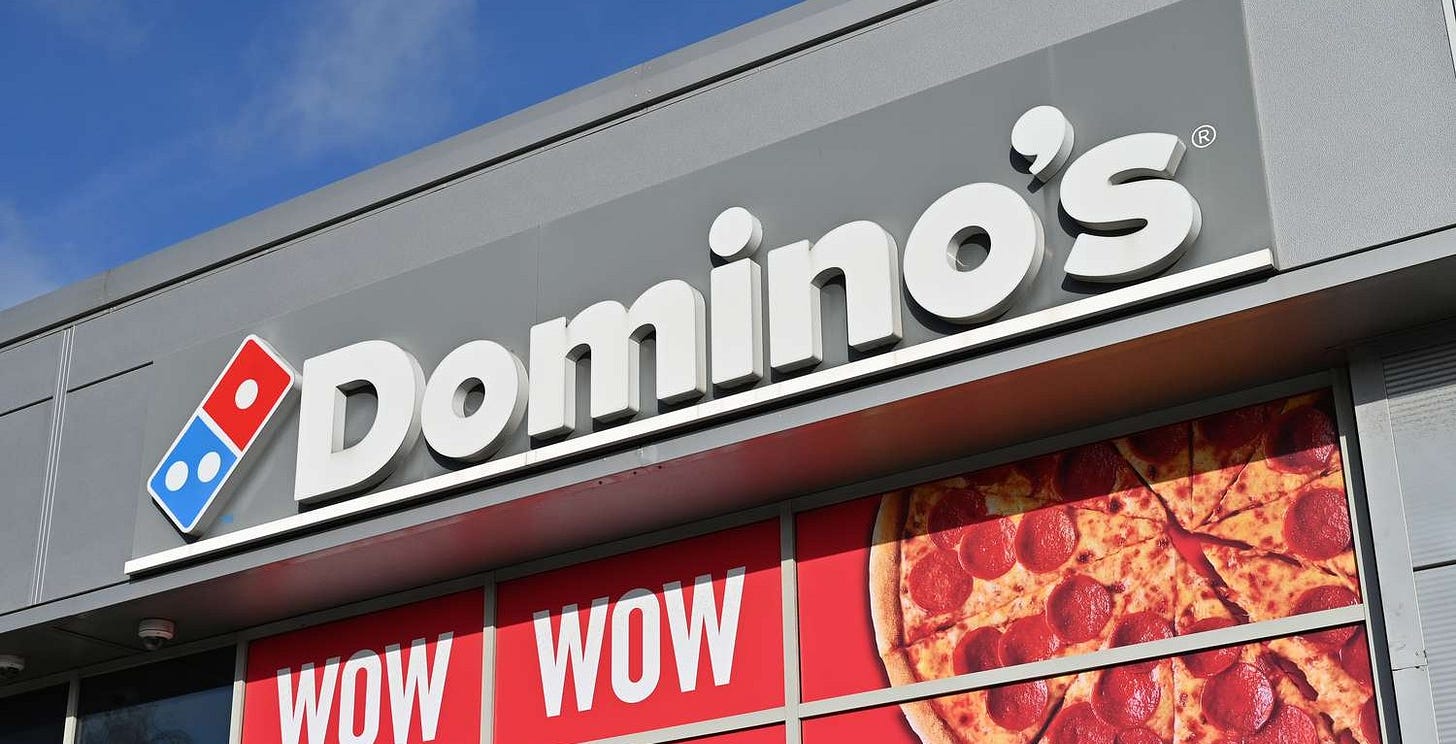Before we jump in, I just wanted to share Steady Investing Portfolio’s performance:
Following a consistent process and checklist has helped Steady Investing's portfolio (as of 5/20/2025) outperform the S&P 500 by over 100%, up 154% vs. 54% for the S&P 500 index, with an annualized return of over 45% (inception date Nov’22).
Cannibal Stocks: The Silent Powerhouses That Grow Your Wealth
Hi Readers!
Today, we’re talking about one of the most underrated yet incredibly powerful investing strategies: Cannibal Stocks.
No, they don’t bite. But they do eat something: their own shares.
Companies that aggressively buy back their own shares, boosting your ownership without you lifting a finger. I’ll explain how this works, why it matters, and share 5 high-quality cannibal stocks, including Visa and Domino’s Pizza, that meet strict criteria.
Buyback of own shares is a good strategy for managers to allocate capital for the right reasons. If you missed the article on Capital Allocation, read it here.
Let's dive in!
What Are Cannibal Stocks?
Cannibal stocks are companies that heavily repurchase their own shares, reducing the total number of shares outstanding. This increases your ownership stake over time without you doing anything! Here’s the magic: if a company earns $10 per share and buys back 50% of its shares, the earnings per share (EPS) double to $20 (since the same profits are spread over fewer shares). If the market keeps the same P/E ratio, the stock price should double too. Investor Mohnish Pabrai calls this a “beautiful compounding mechanism” because it quietly grows your wealth.
Why It Works (When Done Right)
Share buybacks create value only when the stock is undervalued. Think of it as the company investing in itself. If it buys shares cheap, it’s a smart move, just like you’d only buy a stock at a good price.
For example, if Company A’s stock is $10 with a P/E of 5 (undervalued), a $3 million buyback retires 300,000 shares, cutting shares outstanding from 1 million to 700,000. Your 1% stake (10,000 shares) rises to 1.42% (10,000 ÷ 700,000). But if Company B’s stock is $50 with a P/E of 25 (overvalued), the same $3 million buys only 60,000 shares, lifting your stake from 1% to just 1.06%.
Undervalued buybacks pack a bigger punch!
Why Cannibal Stocks Matter to You
Investing in cannibal stocks can supercharge your returns if the company is high-quality and buys back shares at the right price. Your ownership grows, EPS rises, and the stock price often follows.
But beware, buybacks at high valuations can destroy value. That’s why we focus on companies with strong fundamentals and a proven buyback track record.
Our Criteria for High-Quality Cannibal Stocks
We screened for stocks that are true “cannibals” with these strict standards:
ROIC > 15%: High returns on invested capital show efficient growth.
Profit Margin > 10%: Ensures strong profitability.
EPS Growth (Past 5 & 10 Years) > 10%: Proves consistent earnings growth.
Decrease in Shares Outstanding (Past 10 Years) > 25%: Confirms aggressive buybacks.
Here are 5 standout cannibal stocks that meet these criteria, with key stats to show why they’re worth a look.
1. Domino’s Pizza ($DPZ)
The world’s largest pizza chain, Domino’s, has:
Since 2010, it has bought back shares by 41.1%.
ROIC at 56.9% ROIC and
8.6% FCF margin, it’s a cash machine, expecting ~6% FCF growth through 2028. Its 3.5% FCF yield offers value.
2. Ameriprise Financial ($AMP)
A financial planning leader, Ameriprise
Since 2010, it has bought back shares by 57%.
ROIC at 56% ROIC and
~18% FCF growth through 2028. Its 10% FCF yield offers value.
3. Discover Financial Services ($DFS)
Discover, a credit card issuer, reduced shares by 51% since 2010. It boasts a 51.8% FCF margin, 19.2% ROIC, and 13.3% FCF yield, with a 7.5% FCF growth forecast.
Since 2010, it has bought back shares by 51%.
ROIC at 20% ROIC and
Expecting ~8% FCF growth through 2028. Its 13.6% FCF yield offers value.
4. Visa ($V)
Visa, a payments giant:
Since 2010, it has bought back shares by 43%.
ROIC at 28% ROIC and
Expecting ~16% FCF growth through 2028. Its 3.6% FCF yield offers value.
5. Dillard’s ($DDS)
Dillard’s, a department store chain, operates retail department stores located primarily in the United States:
Since 2010, it has bought back shares by 74%.
ROIC at 38% ROIC and
Expecting ~20% FCF growth through 2028. Its 10.6% FCF yield offers value.
Bonus Stocks: I love these 2 companies
6. O’Reilly Automotive ($ORLY)
O’Reilly, an auto parts retailer:
Since 2010, it has bought back shares by 56%.
ROIC at 41% ROIC and
Expecting ~10% FCF growth through 2028. Its 4% FCF yield offers value.
7. AutoZone ($AZO)
Another auto parts leader, AutoZone:
Since 2010, it has bought back shares by 57%.
ROIC at 41% ROIC and
Expecting ~17% FCF growth through 2028. Its 5% FCF yield offers value.
Why These Stocks Stand Out
These 15 companies aren’t just buying back shares; they’re high-quality businesses with strong profitability (profit margins > 10%), efficient capital use (ROIC > 15%), and consistent growth (EPS growth > 10% over 5 years). Their aggressive buybacks, reducing shares by 30% or more since 2010, amplify your returns when valuations are right.
A Quick Word of Caution
Buybacks only work when executed well. Many companies repurchase shares at overvalued prices or to artificially boost EPS short term. That’s not the kind of cannibal you want in your portfolio.
Look for companies with a long-term focus and management with skin in the game.
Final Thoughts
Some of the best compounders in the stock market are also some of the biggest cannibals.
They shrink the share count.
They grow profits.
They reward long-term investors, quietly, steadily, and massively.
About Me
I am a self-taught investor who has read hundreds of books on investing and spends 40+ hours a week researching and analyzing stocks. Steady Investing has a true passion for investing and helping other investors.
I did not come from a finance background, and it took me nearly 10 years from learning about the stock market to finally making my first investment. Since 2022, when I started tracking my performance, I have outperformed the S&P 500 by over 100% with an annualized return of over 43% (inception date Nov’22).
I created this platform to share my investing journey and help others navigate the stock market with confidence.
Let’s grow together. 🚀
Visit my page to access previous posts.
Disclaimer: This post is for educational purposes only and should not be considered financial advice. Always do your research before making investment decisions.













It's the real structure of compounding with the realistic simple variables in composition.
.
It could inspire an investor on how one shall strategize to achieve or maximize it.
The Absolute Total Compound MoAT Investing Dharma 151:
9 Key Signs of a Compounder
i.
IROIA>ROIIC>IGPOIA>GPA>ROIC>ROA>(4×Headline CPI Inflation Rate)
Note:
IROIA
= Incremental Net Profit ÷ Incremental Total Assets
ROIIC
= Incremental Net Profit ÷ Incremental Invested Capital
IGPOIA
= Incremental Gross Profit ÷ Incremental Total Assets
ii.
Gnp ≥ Ggp ≥ Gic > Gasset > (4×Headline CPI Inflation Rate)
iii.
(1 + Gnp)/(1 + Gic) ≥ 1
iv.
MoAT (ROA) > (4×Headline CPI Inflation Rate)
v.
0.75 ≤ ( Cash & Cash Equivalent ÷ Total Liabilities ) < 1
vi.
( Current Asset ÷ Total Liabilities ) > 1
vii.
Current Asset > Total Equity > Total Liabilities > Current Liabilities > Non-Current Asset
viii.
Receivables Turnover Days
= Average Collection Period
= Trade and other receivables, deposits and prepayments ÷ Revenue
≤ 92 days
ix.
0 ≤ D/E ≤ 0.12